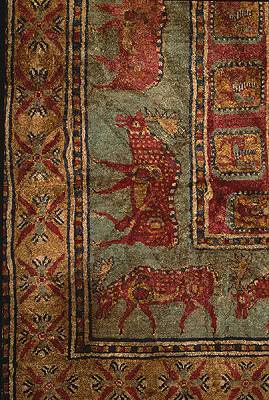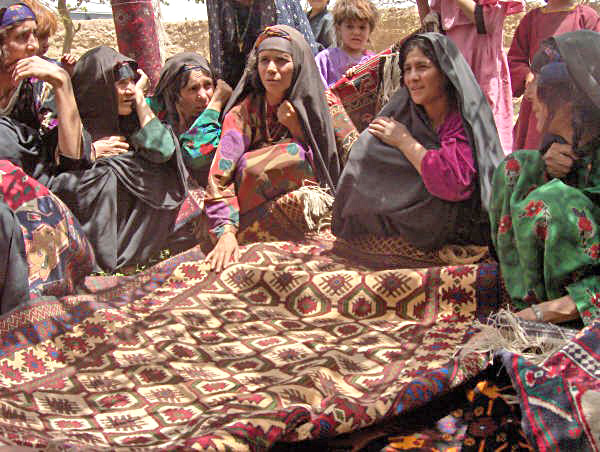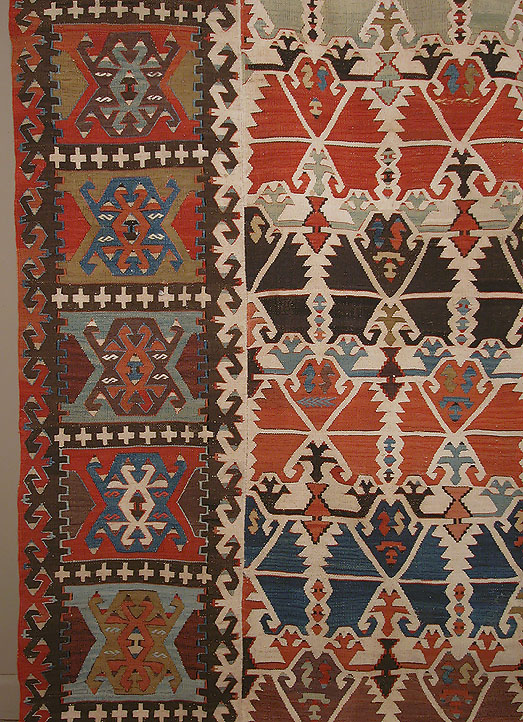|
Rug Making
A rug is a piece of cloth, similar to a carpet, but it does not span the width of a room and is not attached to the floor. It is generally used as a floor covering, or as a decorative feature. Rug making is the process of crafting a rug from various textile materials. Historically, there has been a variety of methods of rug making, including braiding, hooking, and weaving. These processes can be carried out by hand, using smaller tools like a latch hook, or using a weaving machine. Rag rugs are a historically notable and widespread form of hooked rug making. Rug hooking is both an art and a craft where rugs are made by pulling loops of yarn or fabric through a stiff woven base such as burlap, linen, or rug warp. The loops are pulled through the backing material by using a crochet-type hook mounted in a handle (usually wood) for leverage. Braided Braided rugs are made by using three or more strips of fabric, usually wool, folding the raw edges to the middle and braiding them tog ... [...More Info...] [...Related Items...] OR: [Wikipedia] [Google] [Baidu] |
Museum Of English Rural Life
The Museum of English Rural Life, also known as The MERL, is a museum, library and archive dedicated to recording the changing face of farming and the countryside in England. The museum is run by the University of Reading, and is situated in Redlands Road to the rear of the institution's London Road Campus near to the centre of Reading in southern England. The location was formerly known as East Thorpe House and then St. Andrews Hall. It is an accredited museum and accredited archive as recognised by Arts Council England and the National Archives. History The museum's site was originally occupied by a house known as East Thorpe, designed in 1880 by Alfred Waterhouse for Alfred Palmer (of the Reading biscuit manufacturers Huntley & Palmers). Palmer was an important early benefactor of Reading University and in 1911 East Thorpe was extended to become St Andrews Hall, a hall of residence for women attending the university. The museum itself was founded in 1951, growing out of t ... [...More Info...] [...Related Items...] OR: [Wikipedia] [Google] [Baidu] |
Moroccan Rugs
Moroccan rugs are the weaves, carpets, and textiles that have been traditionally hand-woven in Morocco. Rugs have been woven by the indigenous people of Morocco since the Paleolithic Era. Traditionally, Moroccan rugs have been woven by tribal peoples for their utility rather than for decorative purposes. Twentieth-century Moroccan rugs are widely collected in the West, and are almost always woven by tribes people who do not seek nor possess formal artistic training. History In the historic area encompassing the modern nation of Morocco, the tradition of rug-making is just about as old as it is anywhere in the world. The early adoption of rug-making by native Moroccans is certainly due in large part to the distinctive climate of the region: Moroccan rugs may be very thick with a heavy pile, making them useful for the snow-capped Atlas Mountains; or they may be flat woven and light as to suit the hot climate of the Sahara desert.''Moroccan Carpets'' by Brooke Pickering The nomadic M ... [...More Info...] [...Related Items...] OR: [Wikipedia] [Google] [Baidu] |
Tapestry
Tapestry is a form of textile art, traditionally woven by hand on a loom. Tapestry is weft-faced weaving, in which all the warp threads are hidden in the completed work, unlike most woven textiles, where both the warp and the weft threads may be visible. In tapestry weaving, weft yarns are typically discontinuous; the artisan interlaces each coloured weft back and forth in its own small pattern area. It is a plain weft-faced weave having weft threads of different colours worked over portions of the warp to form the design. Tapestry is relatively fragile, and difficult to make, so most historical pieces are intended to hang vertically on a wall (or sometimes in tents), or sometimes horizontally over a piece of furniture such as a table or bed. Some periods made smaller pieces, often long and narrow and used as borders for other textiles. European tapestries are normally made to be seen only from one side, and often have a plain lining added on the back. However, other tradi ... [...More Info...] [...Related Items...] OR: [Wikipedia] [Google] [Baidu] |
Oriental Rug
An oriental rug is a heavy textile made for a wide variety of utilitarian and symbolic purposes and produced in " Oriental countries" for home use, local sale, and export. Oriental carpets can be pile woven or flat woven without pile, using various materials such as silk, wool, and cotton. Examples range in size from pillows to large, room-sized carpets, and include carrier bags, floor coverings, decorations for animals, Islamic prayer rugs ('Jai'namaz'), Jewish Torah ark covers (''parochet''), and Christian altar covers. Since the High Middle Ages, oriental rugs have been an integral part of their cultures of origin, as well as of the European and, later on, the North American culture. Geographically, oriental rugs are made in an area referred to as the “Rug Belt”, which stretches from Morocco across North Africa, the Middle East, and into Central Asia and northern India. It includes countries such as northern China, Tibet, Turkey, Iran, the Maghreb in the west, the Cauc ... [...More Info...] [...Related Items...] OR: [Wikipedia] [Google] [Baidu] |
Knot Density
Knot density is a traditional measure for quality of handmade or knotted pile carpets. It refers to the number of knots, or knot count, per unit of surface area - typically either per square inch (kpsi) or per square centimeter (kpsc), but also per decimeter or meter (kpsd or kpsm). Number of knots per unit area is directly proportional to the quality of carpet.Cucker, Felipe (2013). ''Manifold Mirrors: The Crossing Paths of the Arts and Mathematics'', p.89-90. Cambridge University. . "The knot density...not only provides a measure of the work required to produce a given rug but also sets limits to the possible designs." Density may vary from or higher, where ≤80 kpsi is poor quality, 120 to 330 kpsi is medium to good, and ≥330 kpsi is very good quality. The inverse, knot ratio, is also used to compare characteristics. Knot density = warp×weft while knot ratio = warp/weft. For comparison: 100,000/square meter = 1,000/square decimeter = 65/square inch = 179/''gereh''. Fo ... [...More Info...] [...Related Items...] OR: [Wikipedia] [Google] [Baidu] |
Heatsetting
Heat setting is a term used in the textile industry to describe a thermal process usually taking place in either a steam atmosphere or a dry heat environment. The effect of the process gives fibers, yarns or fabric dimensional stability and, very often, other desirable attributes like higher volume, wrinkle resistance or temperature resistance. Very often, heat setting is also used to improve attributes for subsequent processes. Heat setting can eliminate the tendency of undesirable torquing. At the winding, twisting, weaving, tufting and knitting processes, the increased tendency to torquing can cause difficulties in processing the yarn. When using heat setting for carpet yarns, desirable results include not only the diminishing of torquing but also the stabilization or fixing of the fiber thread. Both twist stabilization and stabilization of frieze effect are results of the heat setting process. Heat setting benefits staple yarns as well as bulked continuous filament (BCF) ya ... [...More Info...] [...Related Items...] OR: [Wikipedia] [Google] [Baidu] |
Gabbeh
Gabbeh or gabba ( fa, گبه) carpets are a traditional variety of Persian carpet. Gabbeh is known as gava in Kurdish and Luri and is also called khersak () in Bakhtiari, literally meaning a "bear's cub". Traditionally a sleeping rug, a gabbeh is a hand-woven pile rug of coarse quality and medium size (90 x 150 cm, 3 by 5 ft, or larger) characterized by an abstract design that relies upon open fields of color and a playfulness with geometry. This type of rug is popular among the populations of the Zagros Mountains of Iran, including Kurdish, Luri and Qashqai people. The gabbeh is usually crafted by women. Gabbeh carpets are much thicker and coarser than other Persian carpets; sometimes they can be as much as one inch or 2.5 cm in depth. In fact, they are more a variety of kilim than carpet A carpet is a textile floor covering typically consisting of an upper layer of pile attached to a backing. The pile was traditionally made from wool, but since the 20th centur ... [...More Info...] [...Related Items...] OR: [Wikipedia] [Google] [Baidu] |
Afghan Carpet
An Afghan rug (or Afghan carpet) is a type of handwoven floor-covering textile traditionally made in the northern and western areas of Afghanistan, mainly by Afghan Turkmens and Uzbeks. Types and varieties One of the most exotic and distinctive of all oriental rugs is the ''Shindand'' or '' Adraskan'' (named after local Afghan towns), woven in the Herat Province, in western Afghanistan. Strangely elongated human and animal figures are their signature look. The carpet can be sold across Afghanistan with the most based in Mazar-e Sharif. Another staple of Afghanistan is Baluchi rugs, most notably Baluchi prayer rugs. They are made by Afghanistan's Baloch people in the south-western part of the country. Various vegetable and other natural dyes are used to produce the rich colors. The rugs are mostly of medium sizes. Many patterns and colors are used, but the traditional and most typical is that of the octagonal elephant's foot (Bukhara) print, often with a red background. Th ... [...More Info...] [...Related Items...] OR: [Wikipedia] [Google] [Baidu] |
Knotted-pile Rug
A knotted-pile carpet is a carpet containing raised surfaces, or piles, from the cut off ends of knots woven between the warp and weft. The Ghiordes/Turkish knot and the Senneh/Persian knot, typical of Anatolian carpets and Persian carpets, are the two primary knots.Goswami, K.K.; ed. (2009). ''Advances in Carpet Manufacture'', p.239. Woodhead Publishing in Textiles: Number 87 ( The Textile Institute). . "The two most common types of knot used in an oriental carpet are the Persian knot and the Turkish knot." A flat or tapestry woven carpet, without pile, is a kilim. A pile carpet is influenced by width and number of warp and weft, pile height, knots used, and knot density. "The structural weft threads alternate with supplementary weft that rises from the surface of the weave at a perpendicular angle. This supplementary weft is attached to the warp by one of three knots... to form the pile or nap of the carpet." Knots are tied in rows, one to each pair of warp threads, which may ... [...More Info...] [...Related Items...] OR: [Wikipedia] [Google] [Baidu] |
Kilim
A kilim ( az, Kilim کیلیم; tr, Kilim; tm, Kilim; fa, گلیم ''Gilīm'') is a flat tapestry- woven carpet or rug traditionally produced in countries of the former Persian Empire, including Iran, the Balkans and the Turkic countries. Kilims can be purely decorative or can function as prayer rugs. Modern kilims are popular floor coverings in Western households. Etymology The term 'kilim' originates from the Persian ''galīm'' (گلیم) where it means 'to spread roughly', perhaps of Akkadian or Aramean origin. another name for Galim(Gilim) is Plas, Ferdowsi and other persian poet mentioned both Galim and plas as synonyms in Shahnameh No 35 mentioned as Plas(pluNo14 mentioned as Gali History Like Pile weave, pile carpets, kilim have been produced since ancient times. The explorer Mark Aurel Stein found kilims dating to at least the fourth or fifth century CE in Hotan, China: :"As kilims are much less durable than rugs that have a pile to protect the warp and weft, i ... [...More Info...] [...Related Items...] OR: [Wikipedia] [Google] [Baidu] |
Carpet Manufacturing Ganja XIXcentury
A carpet is a textile floor covering typically consisting of an upper layer of pile attached to a backing. The pile was traditionally made from wool, but since the 20th century synthetic fibers such as polypropylene, nylon, or polyester have often been used, as these fibers are less expensive than wool. The pile usually consists of twisted tufts that are typically heat-treated to maintain their structure. The term ''carpet'' is often used in a similar context to the term ''rug'', but rugs are typically considered to be smaller than a room and not attached to the floor. Carpets are used for a variety of purposes, including insulating a person's feet from a cold tile or concrete floor, making a room more comfortable as a place to sit on the floor (e.g., when playing with children or as a prayer rug), reducing sound from walking (particularly in apartment buildings), and adding decoration or color to a room. Carpets can be made in any color by using differently dyed fibers. Ca ... [...More Info...] [...Related Items...] OR: [Wikipedia] [Google] [Baidu] |









